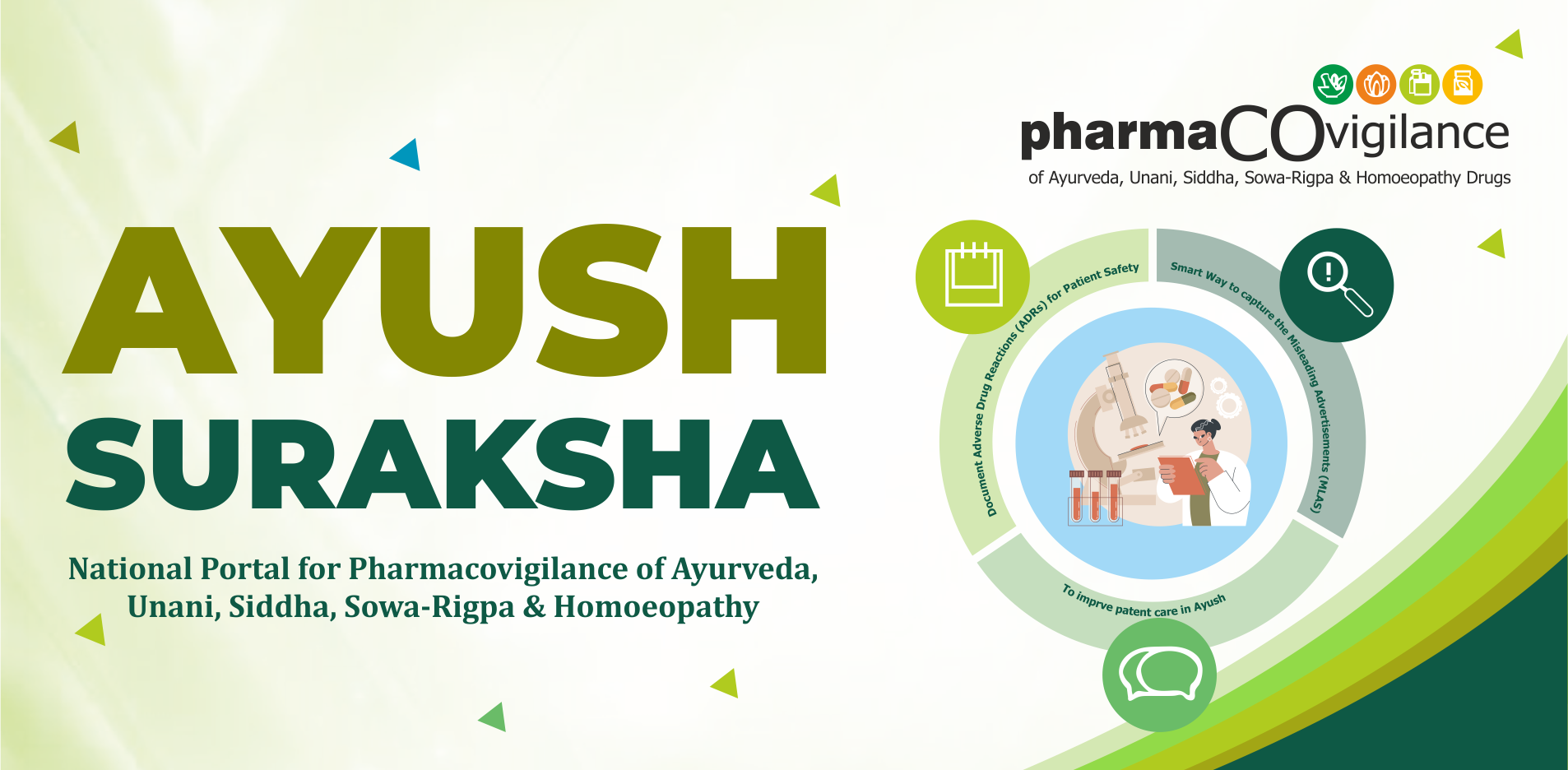Frequently Asked Questions (FAQs)
-
What is Pharmacovigilance?
Science and activities relating to the Detection, Assessment, Understanding, Prevention of adverse effects or any other drug-related problem.
-
What is its scope?
The scope of Pharmacovigilance extends across various aspects of drug safety and monitoring. It plays a crucial role in ensuring that medications remain safe and effective throughout their lifecycle. It is the only way to protect the Patients and Consumers through its reporting.
-
How many Ayush Pharmacovigilance centres are available in India?
One National Pharmacovigilance Coordination Cente (NPvCC), Five Intermediary Centres (5-IPvCs) and 97 Peripheral Centers (97-PPvCs).
-
What are the two pillars of this portal?
Documenting the Adverse Drug Reactions (ADR)
Capturing the Objectionable advertisements (OA)/ Misleading Advertisements (MLA).
-
What is Patient Safety?
Patient Safety is a healthcare discipline that emerged with the evolving complexity of healthcare systems and the resulting rise of patient harm in healthcare facilities.
-
What is Adverse Drug Reaction (ADR)?
Noxious and unintended, and which occurs at doses normally used in man for the prophylaxis, diagnosis or therapy of disease, or the modification of physiological function.
-
What is an Adverse Event?
Any untoward medical occurrence that may present during treatment with a pharmaceutical product, but which does not necessarily have a causal relationship with this treatment.
-
What is a Serious Adverse Event?
Any event which causes death, permanent damage, birth defects, or requires prolonged hospitalization.
-
Who can report the ADRs?
Any Health Care Professional including Doctors, Nurses, Pharmacists can report the ADRs. Patients can report through their Physician/ Medical Faculty Member.
-
When to report an ADR?
Report as soon as you suspect that drug/ therapy has resulted in a negative, unintended effect.
-
Where to Report?
The suspected ADRs can be reported to the designated structures of Peripheral Pharmacovigilance Centers (PPvCs) and Intermediary Pharmacovigilance Centers (IPvCs) available across the country.
-
Why should ADRs be reported?
Reporting ADRs helps improve patient safety, safeguard public health, and enhance drug monitoring.
-
Why is Pharmacovigilance important for AYUSH?
It helps to address the common misconception that natural medicines are always safe and to ensure that AYUSH medicines are used responsibly, especially when combined with other medications.
-
What is an Objectionable Advertisement (OA)?
An objectionable advertisement refers to any promotional content that is misleading, deceptive to consumers. They not only have detrimental effects, but have a direct implication over health status of the consumer, and bring a bad reputation to the healthcare system. In India, the Drugs and Magic Remedies (Objectionable Advertisements) Act, 1954 regulates advertisements related to drugs and medical treatments to prevent false claims and protect public health.
-
What is a Misleading Advertisement (MLA)?
Any advertisement or promotion through Television, Radio, or any other electronic media, Newspapers, Banners, Posters, Handbills, wall-writing etc. to misrepresent the nature, characteristics, qualities or geographic origin of goods, services or commercial activities to mislead the consumer could be broadly defined as a misleading advertisement.
-
How does pharmacovigilance address misleading advertisements for Ayush drugs?
Ayush Suraksha monitors and reports Objectionable advertisements (OA)/ Misleading Advertisements (MLAs) to relevant authorities for appropriate action.
-
What are the key aspects of the Objectionable Advertisements?
Misleading Claims: Advertisements that falsely promise miraculous cures or exaggerated benefits.
Prohibited Diseases: Advertisements promoting treatments for conditions like cancer, diabetes, infertility etc. without scientific backing.
Magic Remedies: Advertisements endorsing talismans, mantras, or other unscientific methods for medical treatment.
Consumer Protection: The law ensures that advertisements do not exploit vulnerable individuals seeking medical solutions.
-
How to Report an OA/MLA?
Anyone can report an OA or MLA, through the designated structures of Peripheral Pharmacovigilance Centers (PPvCs), Intermediary Pharmacovigilance Centers (IPvCs), and National Pharmacovigilance Coordination Centres (NPvCC).
There is a specific public complaint form that is also available on Portal.
-
Who can report the Objectionable advertisements (OA)/ Misleading Advertisements (MLAs)?
Any individual can submit including the health care providers.
-
What is the misleading advertisements relating to drugs?
(a) directly or indirectly gives a false impression regarding the true character of the drug, or
(b) makes a false claim for the drug. or
(c) is otherwise false or misleading in any material particular

